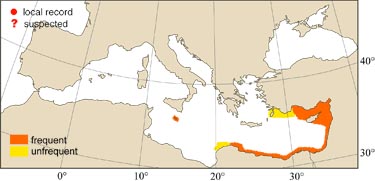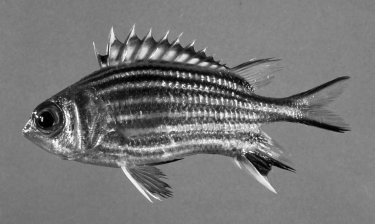|
|
|
SHORT
DESCRIPTION
Body oblong and moderately compressed. Head profile slightly convex; its bones with grooves, ridges and spinules. A strong spine at the lower corner of preoperculum subequal to eye diameter. 1-2 spines on the posterior edge of operculum at eye level. Large eye, 2.5-2.7 times in head length. Terminal mouth with villiform teeth. Coarsely ctenoid scales.
color :
body with alternating longitudinal red and whitish yellow stripes of about the same width.
size :
common 12-22 cm (max. 27 cm).
|
|
DISTINGUISHING CHARACTERISTICS
The color pattern and the strong spine at the lower angle of preoperculum distinguishes this fish from all other Mediterranean species.
BIOLOGY / ECOLOGY
A nocturnal species. During daytime inhabits caves and crevices at depths of 10-40 m. Feeds mainly on decapods and to a lesser extent, on polychaetes, isopods, molluscs and fish. Spawning season from July to August. Pelagic eggs and larvae. Early stage (until 30 mm) characterized by a long rostral preopercular and supraocipital spines. Settles in rocky habitat when reach 30-35 mm.
habitat :
rocky.
|
|
|
|
1st
MEDITERRANEAN RECORD
Palestine, 1947.
|
|

|
|
DISTRIBUTION
Worldwide : Red Sea, eastern Africa to Durban, wide Indian-Pacific to Samoa and Japan. Mediterranean : recorded first in Palestine (Haas and Steinitz, 1947); successively recorded in Rhodes (Lakaridis, 1948b), Cyprus (Demetropoulos and Neocleous, 1969) and Libya (Stirn, 1970).
|
|
ESTABLISHMENT SUCCESS
Very common.
speculated reasons for success :
paucity of nocturnal competitors might facilitate its population growth.
|
MODE OF
INTRODUCTION
Via the Suez Canal.
|
|
IMPORTANCE TO
HUMANS
Caught in small quantities mainly by trammel net, occasionally by hook and line.
|
|
|
|
KEY
REFERENCES
- Ben-Eliahu M.N., Golani D. and Ben-Tuvia A., 1983. On predation on polychaetes (Annelida) by the squirrelfish Adioryx ruber (Holocentridae) with a new polychaete record for the Mediterranean coast of Israel. Tethys, 11(1): 15-19.
- Golani D., 1987. Comparison of morphomeristical variations of Mediterranean and Red Sea populations of the Suez Canal migrant Sargocentron rubrum. Centro, 3: 24-31.
- Golani D. and Ben-Tuvia A., 1985. The biology of the Indo-Pacific squirrelfish, Sargocentron rubrum (Forsskål), a Suez Canal migrant to the eastern Mediterranean. Journal of Fish Biology, 27: 249-258.
|
|
- Golani D., Ben-Tuvia A. and Galil B., 1983. Feeding habits of the Suez Canal migrant squirrelfish, Sargocentron rubrum, in the Mediterranean Sea. Israel Journal of Zoology, 32: 194-204.
- Haas G. and Steinitz H., 1947. Erythrean fishes on the Mediterranean coast of Palestine. Nature, 160: 28.
FEEDBACK
/ COMMENTS TO AUTHORS |
|


 Adioryx ruber
Adioryx ruber